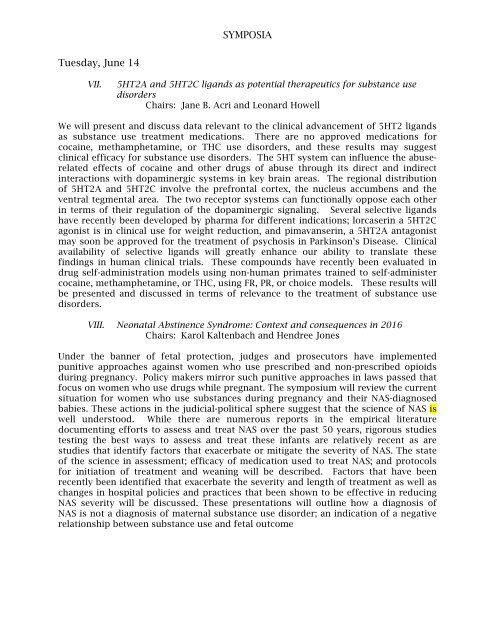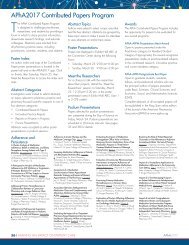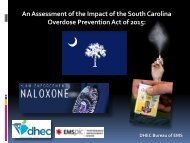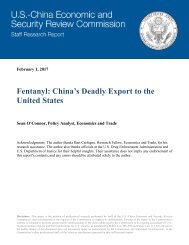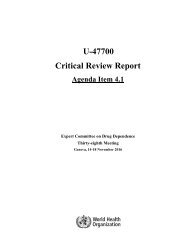CPDD 78th Annual Scientific Meeting Program
2016-78th-CPDD-Program-Book-6-07-16FINAL
2016-78th-CPDD-Program-Book-6-07-16FINAL
You also want an ePaper? Increase the reach of your titles
YUMPU automatically turns print PDFs into web optimized ePapers that Google loves.
SYMPOSIA<br />
Tuesday, June 14<br />
VII.<br />
5HT2A and 5HT2C ligands as potential therapeutics for substance use<br />
disorders<br />
Chairs: Jane B. Acri and Leonard Howell<br />
We will present and discuss data relevant to the clinical advancement of 5HT2 ligands<br />
as substance use treatment medications. There are no approved medications for<br />
cocaine, methamphetamine, or THC use disorders, and these results may suggest<br />
clinical efficacy for substance use disorders. The 5HT system can influence the abuserelated<br />
effects of cocaine and other drugs of abuse through its direct and indirect<br />
interactions with dopaminergic systems in key brain areas. The regional distribution<br />
of 5HT2A and 5HT2C involve the prefrontal cortex, the nucleus accumbens and the<br />
ventral tegmental area. The two receptor systems can functionally oppose each other<br />
in terms of their regulation of the dopaminergic signaling. Several selective ligands<br />
have recently been developed by pharma for different indications; lorcaserin a 5HT2C<br />
agonist is in clinical use for weight reduction, and pimavanserin, a 5HT2A antagonist<br />
may soon be approved for the treatment of psychosis in Parkinson’s Disease. Clinical<br />
availability of selective ligands will greatly enhance our ability to translate these<br />
findings in human clinical trials. These compounds have recently been evaluated in<br />
drug self-administration models using non-human primates trained to self-administer<br />
cocaine, methamphetamine, or THC, using FR, PR, or choice models. These results will<br />
be presented and discussed in terms of relevance to the treatment of substance use<br />
disorders.<br />
VIII. Neonatal Abstinence Syndrome: Context and consequences in 2016<br />
Chairs: Karol Kaltenbach and Hendree Jones<br />
Under the banner of fetal protection, judges and prosecutors have implemented<br />
punitive approaches against women who use prescribed and non-prescribed opioids<br />
during pregnancy. Policy makers mirror such punitive approaches in laws passed that<br />
focus on women who use drugs while pregnant. The symposium will review the current<br />
situation for women who use substances during pregnancy and their NAS-diagnosed<br />
babies. These actions in the judicial-political sphere suggest that the science of NAS is<br />
well understood. While there are numerous reports in the empirical literature<br />
documenting efforts to assess and treat NAS over the past 50 years, rigorous studies<br />
testing the best ways to assess and treat these infants are relatively recent as are<br />
studies that identify factors that exacerbate or mitigate the severity of NAS. The state<br />
of the science in assessment; efficacy of medication used to treat NAS; and protocols<br />
for initiation of treatment and weaning will be described. Factors that have been<br />
recently been identified that exacerbate the severity and length of treatment as well as<br />
changes in hospital policies and practices that been shown to be effective in reducing<br />
NAS severity will be discussed. These presentations will outline how a diagnosis of<br />
NAS is not a diagnosis of maternal substance use disorder; an indication of a negative<br />
relationship between substance use and fetal outcome


